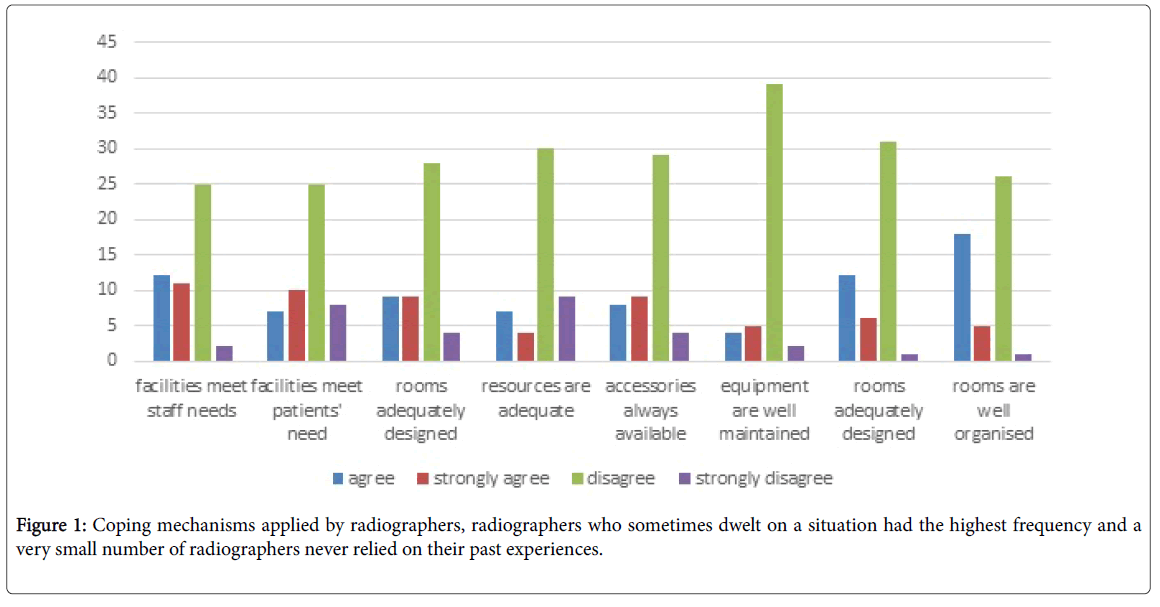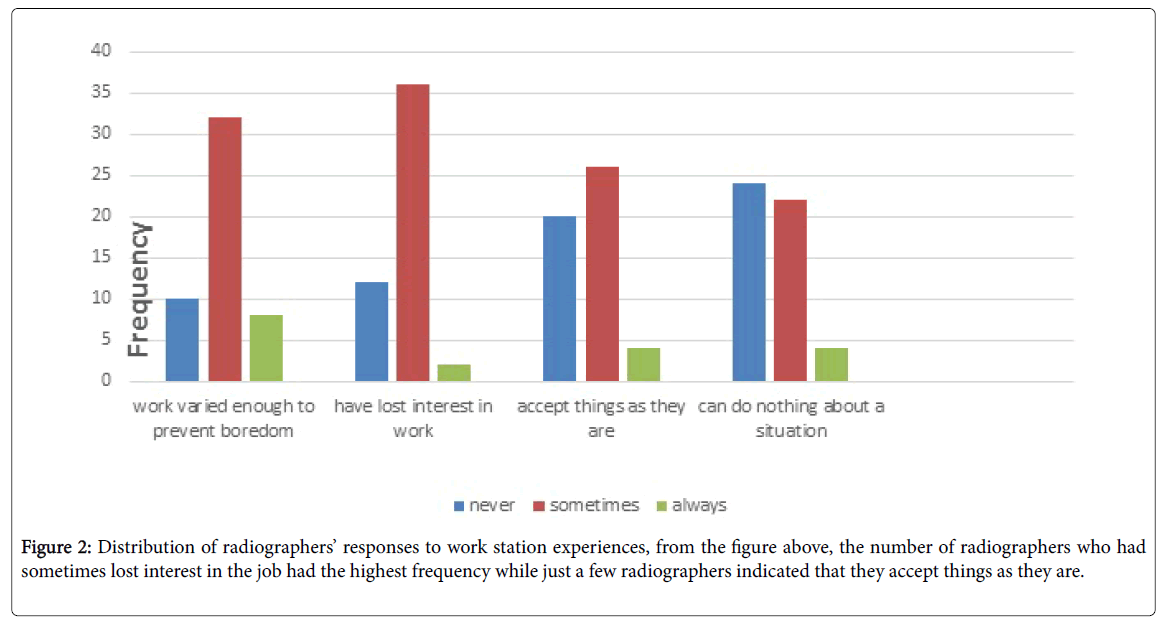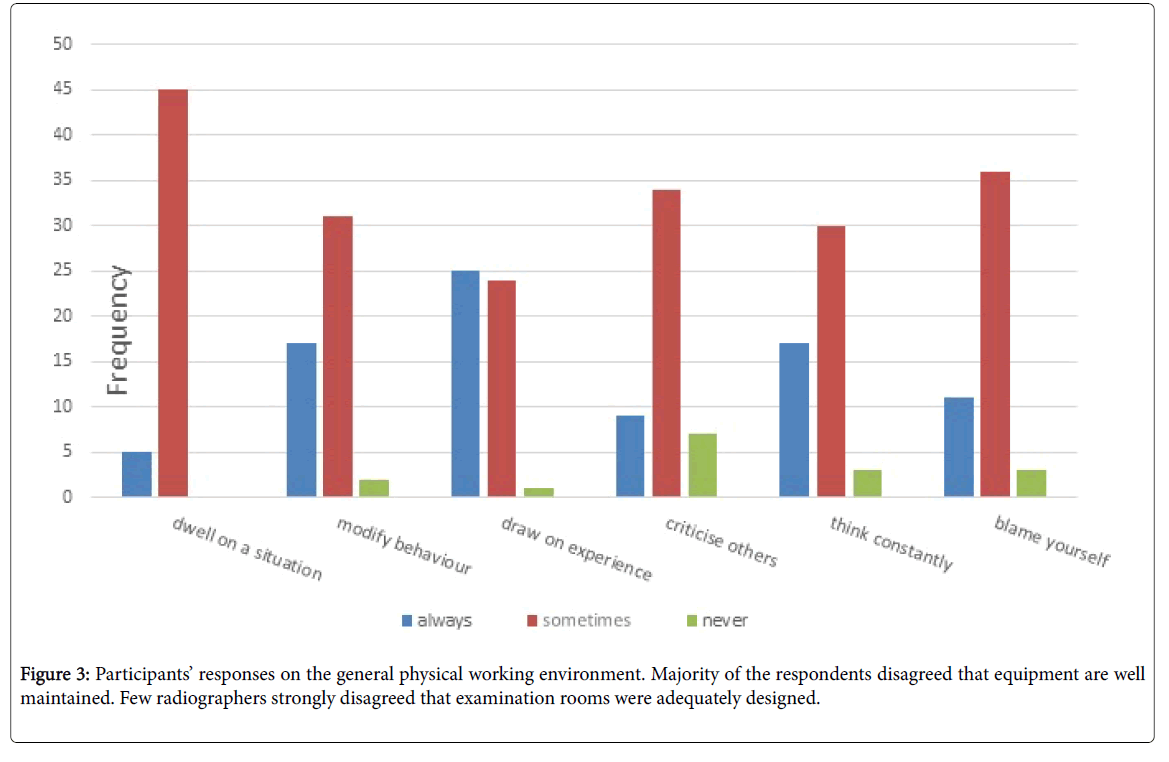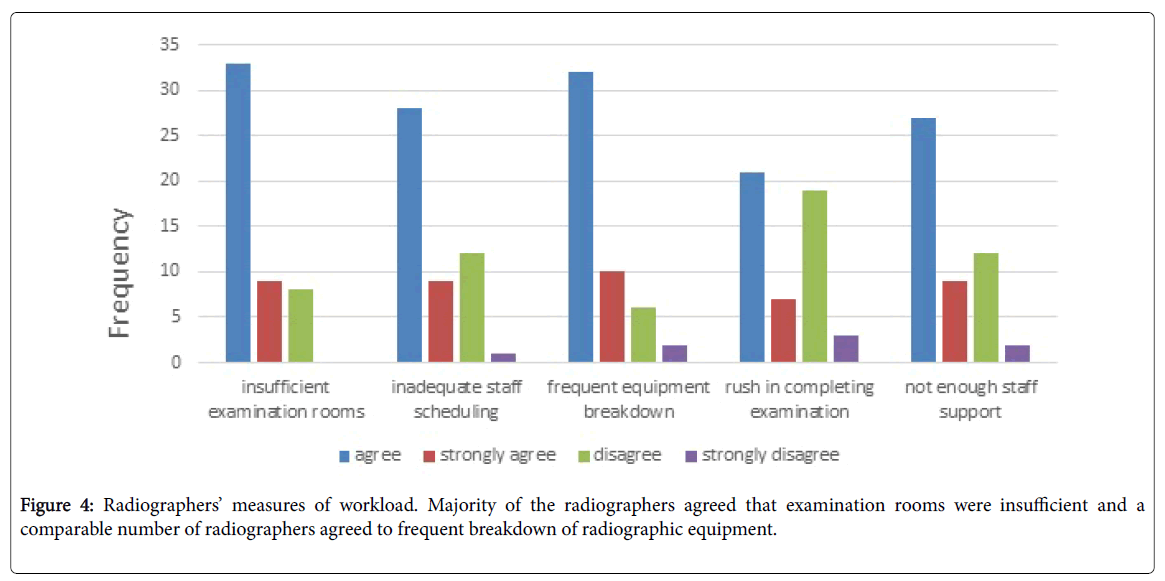Research Article Open Access
Psychosocial Stress and Its Predictors among Radiographers in Ghana
Kyei KA*, Amoabeng KA, Sule D, Antwi WK and Anim-Sampong SDepartment of Radiography, University of Ghana, Accra, Ghana
- Corresponding Author:
- Kofi Adesi Kyei
Department of Radiography
School of Biomedical and Allied Health Sciences
College of Health Science, University of Ghana, P.O. Box KB 143, Korle-Bu, Accra, Ghana
Tel: +233-207007124
E-mail: kakyei@chs.edu.gh
Received Date: November 21, 2016; Accepted Date: December 20, 2016; Published Date: December 26, 2016
Citation: Kyei KA, Amoabeng KA, Sule D, Antwi WK, Anim-Sampong S (2016) Psychosocial Stress and Its Predictors among Radiographers in Ghana. OMICS J Radiol 5:245. doi: 10.4172/2167-7964.1000245
Copyright: © 2016 Kyei KA, et al. This is an open-access article distributed under the terms of the Creative Commons Attribution License, which permits unrestricted use, distribution, and reproduction in any medium, provided the original author and source are credited.
Visit for more related articles at Journal of Radiology
Abstract
Background: Stress is a feeling of strain and pressure and can be defined as the disparity between comprehension of the requirements on one side and the ability to cope with this demand on the other side. Psychosocial stress results when it is recognised that perceived threats, real or even imagined, may require unavailable resources.
Aim: The study was aimed at investigating psychosocial stress, its predictors and coping mechanisms among radiographers at the study site.
Methods: A cross-sectional survey was used for the study. A questionnaire consisting closed ended questions and sectioned into 8 parts was developed and used as a data collection tool for the study. Fifty radiographers were used for the study. SPSS, version 20 was used in the data processing and analysis.
Results: A response rate of 90.9% was achieved for the study. The results showed that 72% radiographers had lost interest in the work. Also, 78% radiographers revealed they had to work with inadequate equipment and accessories. Also, 70% of the respondents revealed that they were not exposed to courses relevant to their profession. Most radiographers also experienced a higher workload.
Conclusion: The general physical working environment, the experience of radiographers concerning their workstation, the non-utilisation of radiographers’ skills and abilities and the absence of staff exposure to necessary courses were rated as a moderate source of psychosocial stress. Role ambiguity was rated as a very low source of psychosocial stress. Role conflict and workload were rated as a high source of psychosocial stress.
Keywords
Psychosocial stress; Radiographers; Workload; Role conflict
Introduction
Stress is a feeling of strain and pressure and can be defined as the disparity between comprehension of the requirements on one side and our ability to cope with this demand on the other side [1]. Symptoms may include a sense of being overwhelmed, feelings of anxiety, overall irritability, insecurity, nervousness, social withdrawal, loss of appetite, depression, panic attacks, exhaustion, high or low blood pressure, skin eruptions or rashes, insomnia, migraine, gastrointestinal difficulties (constipation or diarrhoea), and menstrual symptoms for women. It may also cause more serious conditions such as heart problems [2]. Psychosocial stress results when perceived threats, real or even imagined are considered and recognised that they may require unavailable resources. A consequence is that psychosocial stress creates elevated blood pressure and blood sugar levels [2].
The findings of a study conducted at a Manchester hospital revealed that one in 12 health workers including radiographers suffered from mental ill-health which required treatment [3]. This supports the view that health care service presents a stressful environment. Work-related strain may include psychological strain such as cognitive effects, inability to concentrate, and anxiety, behavioural strain such as resorting to smoking or alcohol, and physiological strain such as increased hypertension [4]. Specific stressors identified included work demands (particularly work load or pressure and insufficient time to complete scheduled tasks). Others were emotional labour, traumatic work experience and violence from clients), low control (low skill discretion, low participation in decision making), imbalance between efforts expended and rewards received from work, low support (unsupportive supervisor), role issues (role ambiguity, role conflict, conflict between personal goals and organisational goals), and interpersonal conflict [5]. In the health care sector, a satisfactory psychosocial work environment can be described as the positive conditions and circumstances under which health care providers including radiographers work and these are linked to social factors, individual behaviour and thought.
A study has shown that an adequate psychosocial work environment empowers the staff by offering them freedom to act and opportunities to influence the work [6]. For health care personnel, a healthy psychosocial work environment involves the human environment, work conditions and circumstances in which they live and work. It also includes a reciprocal relationship with other health care professionals and patients [7]. Job satisfaction can be seen as an indicator of the psychosocial work environment, and it is sometimes assumed that job satisfaction, in turn, affects the well-being and health of an organisation’s members and therefore the efficiency of the organisation itself [8]. This makes job satisfaction important within the working environment.
Employees’ perceptions of their psychosocial work environment are crucial not only for their job satisfaction, but also for their health, wellbeing and meaningful leisure time. In recent years, studies have revealed that a significant number of health professionals are not satisfied with their job and the related working conditions [9]. In relation to the psychosocial work environment, there are some facets that both directly and indirectly affect the perception of the working situation. One of the most important aspects is quantitative demands. The study was aimed at investigating psychosocial stress, its predictors and coping mechanisms among radiographers in Ghana.
Methodology
A cross-sectional survey was used for the study. The total enumeration sampling method was used to select 55 therapy and diagnostic radiographers in the one of the Universities. This was because it required that all respondents who met the inclusion criteria are used and particularly for small populations in which all subjects are known. A standard questionnaire consisting of closed ended questions and sectioned into 8 parts was developed and used as a data collection tool for the study from Lundstrom et al. [10].
Section A consisted of questions that pertained to the demographic characteristics of the participants. Section B consisted of questions relating to the experience of radiographers in the work station. Section C contained questions intended to obtain information about the general physical working environment in which radiographers work while Section D consisted of questionnaires on career development. Section E was related to the workload on radiographers. Sections F-H pertained to role ambiguity, role conflict and the coping mechanisms applied by radiographers respectively. The questionnaires were administered and collected in person.
Data was analysed and processed using Statistical Package for Social Sciences version 20. Recorded responses were tallied from the collected data and the frequencies and percentages calculated from the raw data. The results were also presented in graphs and charts.
Ethical approval was sought from the Ethics and Protocol Review Committee before commencement of the study. Written consents were obtained from the participants after explanations of the research aim including their roles in the study were provided them.
Results
A total of 55 radiographers were initially recruited for the study but 5 of them were not present at the time of the study. Hence only 50 radiographers finally engaged in the study yielding a response rate of 90.9%. The demographic characteristics of the 50 radiographers are shown in Figure 1. With respect to age demographics, the highest percentage (n=24, 48%) were found in the age range of 20-29 years, with a corresponding gender distribution of 70% males (n=35) and 15% (n=30) females. Most of the participants were married (n=30, 60%) (Figures 2-4).
Discussion
A 90.9% response rate was achieved in this study. Comparatively, this result can be rated as excellent with respect to a previous radiographer stress-related study by Eslick and Raj [11] which reported a 97% response rate. The results revealed a disproportion in representation with respect to gender as there were only 15 female respondents. A fair balance in age distribution and marital status was also revealed. The results also showed that a reasonable number of radiographers had been working in the department for more than 5 years. According to Gjerdingen et al. [12], psychosocial stress factors such as quantitative demands, intellectually demanding work, and tight deadlines have a more negative influence on men than women. Also, it is only in women that psychosocial stress factors show significant association with musculoskeletal complaints [13].
Experience about a Work Station
From the results, 64% of the respondents revealed that their work was sometimes varied enough to prevent boredom. Per the professional practise, it is necessary to rotate radiographers from one imaging unit to the other at least on a monthly basis to prevent boredom. This rotational schedule helps radiographers gain experience in other modalities such as CT, MRI and Fluoroscopy. Also 72% (n=36) of radiographers reported that they sometimes lost interest in the work whiles 24% indicated that they had never lost interest. Hence, based on the results, experience about the work station could be rated as moderate resulting in psychosocial stress.
General physical working environment
According to Mackay and Risk [14], the general physical working environment influences an employee’s perception of organisational support. They indicated that although radiographers’ perception of trust, support and leadership was satisfactory, the non-involvement of radiographers in decision making influenced the general physical working environment. Per the results, 66% of the radiographers felt that the physical conditions for staff were not satisfactory and hence facilities did not meet staff needs. Also 54% of the respondents felt that equipment and accessories were poorly maintained and 78% of radiographers revealed that equipment and resources were inadequate. General working environment can therefore be rated as a moderate source of psychosocial stress among radiographers. These results are consistent with the work of Lundstrom et al. [10] who reported that elements such as unavailability and poor maintenance of equipment and accessories could influence negatively on the general working environment of radiographers and hence increase their psychosocial stress levels.
Measures of workload
From the results, 56% radiographers rushed in completing examinations such that there was not enough time to give proper instructions and emotional care to in-patients. These impacts negatively on the quality of healthcare delivered. Insufficient radiographic examination rooms were reported by 84% of the radiographers. This result could be inadequate service provision by the radiology department as patients would have to wait for a long periods. Inadequate staff scheduling was reported by 74% of the radiographers. Again, 72% radiographers had to work without adequate staff to assist them effectively in performing their tasks. Frequent equipment breakdown was also experienced by 84% of the respondents and this contributes to additional waiting time of patients and frustration. This confirms Johnson’s [15] assertion that this can lead to tension in interpersonal relationships at work coupled with tiredness from quantitative work overload. From the data, workload could be rated as a very high source of psychosocial stress among radiographers.
Mechanisms of coping applied by radiographers
Generally, some coping mechanisms applied by radiographers are effective in dealing with psychosocial stress and are useful in assisting them in maintaining their commitment to the profession. These coping methods could also contribute to reducing the levels of psychosocial stress experienced by them. Majority of the respondents (90%) indicated that they sometimes dwelt on what should have been done. In addition, 50% always drew on experiences and 68% sometimes blamed and criticised others. Lastly, the radiographers revealed that 72% sometimes blamed or criticised themselves. This practise is consistent with the studies of Treven [16] who indicated that individual strategies for coping with psychosocial stress are often physical activity, meditation and other methods of relaxing, healthy life style and time management. This is also consistent with a similar study by Okutan [17], who asserted that despite the stressful situations in the workplace, employees are able to cope with it.
Conclusion
The findings of this study showed that radiographers were overall psychosocially stressed with their jobs. General physical working environment was rated as a moderate source of psychosocial stress. The non-utilisation of radiographers’ skills and abilities and the absence of staff exposure to necessary courses were also rated as a moderate source of psychosocial stress. In addition, the experience of radiographers about their workstation moderately influenced their stress levels. Role ambiguity was rated as a very low source of psychosocial stress. However, role conflict was rated as a high source of psychosocial stress. Overall, workload was also rated as a high source of psychosocial stress among the radiographers. Despite the stressful situations in the workplace, radiographers were able to cope with it.
Recommendations
• Efforts must be made to ensure that all radiographers benefit from a clear career structure that develops their knowledge and skills. For example, having more internal continuous education courses on Quality Assurance.
• Radiographers must have a job description that integrates the department’s mission and vision, as well as clear plans and goals according to their skills and knowledge and must be clearly defined in their respective responsibilities.
References
- Ivanko S, Stare J (2007) Work related stress in healthcare. University of Ljubljana, Ljubljana, Slovenia.
- Jones F, Bright J, Clow A (2001) Stress: myth, theory, and research.Pearson Education.
- Ahola K, Hakanen J (2007) Job strain, burnout, and depressive symptoms: A prospective study among dentists. J Affect Disord104: 103-110.
- Schnall PL, Belkic KL, Landsbergis PA, Schwartz JE, Baker D,et al. (2001) The need for work site surveillance of hypertension' Third International Conference on Work Environment and Cardiovascular Diseases, Dusseldorf, Germany.
- Rutter DR, Lovegrove MJ (2008) Occupational stress and its predictors in radiographers. Radiography 14: 138-143.
- BégatI,Severinsson E (2006) Reflection on how clinical nursing supervision enhances nursesexperiences of well-being related to their psychosocial work environment. J NursManag 14: 610-616.
- Theorell T (2003) Psychosocial environment and stress. Student literature Lund, pp: 11-73.
- Ommen O, Driller E, Köhler T, Kowalski C, Ernstmann N, et al.(2009) The relationship between social capital in hospitals and physician job satisfaction. BMC Health Service Res 9: 81.
- Smith R (2001) Why are doctors so unhappy? Br Med J 322: 1073-1074.
- Lundstrom T, Pugliese G, Bartley J, Cox J,Guither C (2002) Organisational and environmental factors that affect worker health and safety and patient outcomes. Am J InfControl 30:93-106.
- Eslick GD, Raj VV (2002) Occupational stress among radiographers: does working in private or public practice make a difference. Radiography 8:47-53.
- Gjerdingen D, McGovern P, Bekker M, Lundberg U, Willemsen T (2000) Women's work roles and their impact on health, well-being, and career: comparisons between the United States, Sweden, and The Netherlands. Women Health 31:1-20.
- Östergren PO, Hanson BS, Balogh I, Ektor-Andersen J, Isacsson (2005) Incidence of shoulder and neck pain in a working population: effect modification between mechanical and psychosocial exposures at work. J EpidemiolComm Health 59:721-728.
- Mackay G, Risk M (2001) Building Quality Practice Settings: An Attitude Model. Can J Nurs Lead 14:1-9.
- Johnson L (1990) Enhancing the image of radiographers. Radiographer 37: 71-75.
- Treven S (2005) Strategies and programs for managing stress in work settings. J Contemp Manage Issues 10: 45-59.
- Okutan M,Tengilimoglu D (2002) Stress in working environment and ways of stress management: a field study application. J GaziUni Econ Bus AdmFac 3:19-24.
Relevant Topics
- Abdominal Radiology
- AI in Radiology
- Breast Imaging
- Cardiovascular Radiology
- Chest Radiology
- Clinical Radiology
- CT Imaging
- Diagnostic Radiology
- Emergency Radiology
- Fluoroscopy Radiology
- General Radiology
- Genitourinary Radiology
- Interventional Radiology Techniques
- Mammography
- Minimal Invasive surgery
- Musculoskeletal Radiology
- Neuroradiology
- Neuroradiology Advances
- Oral and Maxillofacial Radiology
- Radiography
- Radiology Imaging
- Surgical Radiology
- Tele Radiology
- Therapeutic Radiology
Recommended Journals
Article Tools
Article Usage
- Total views: 4310
- [From(publication date):
December-2016 - Mar 29, 2025] - Breakdown by view type
- HTML page views : 3381
- PDF downloads : 929




